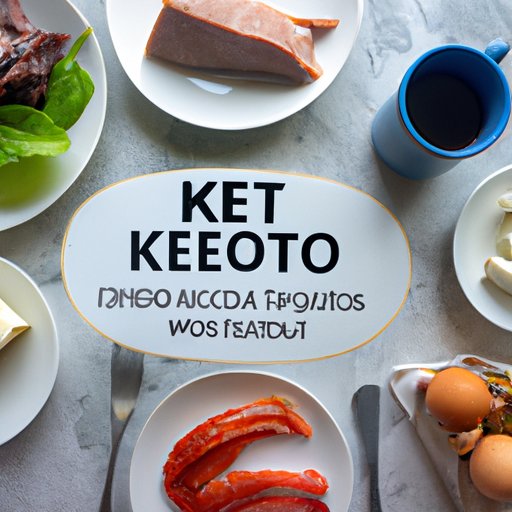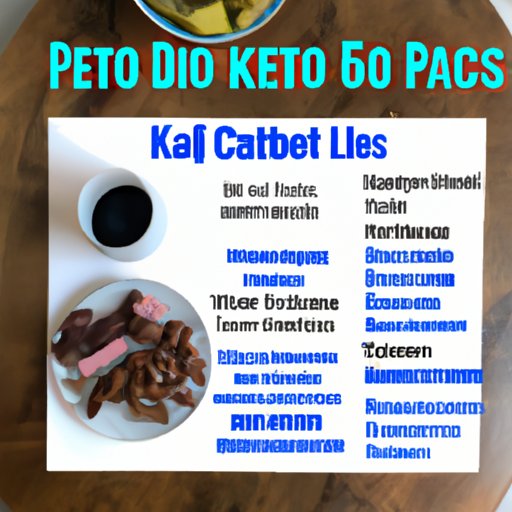Introduction
The ketogenic diet, or “keto” for short, is a high-fat, low-carbohydrate diet that has been gaining popularity in recent years. Unlike other diets, the keto diet focuses on achieving an optimal balance of macronutrients, including fats, proteins, and carbohydrates. When followed correctly, the keto diet can provide numerous health benefits, such as improved energy levels, weight loss, and reduced inflammation.
Overview of Keto Diet and its Benefits
A keto diet is a type of low-carbohydrate diet that focuses on a balance of macronutrients. The goal of the diet is to achieve ketosis, which is a metabolic state where your body burns fat for fuel instead of glucose. To achieve this state, you must restrict your daily carbohydrate intake to 20–50 grams per day and increase your fat intake to 70–80% of your total calories.
When following a keto diet, it’s important to focus on nutrient-dense whole foods. This includes healthy fats such as avocados, nuts, and seeds, as well as protein sources like eggs, fish, and poultry. Vegetables are also encouraged, but should be limited to low-carb options such as leafy greens and cruciferous vegetables. Processed foods and refined sugars should be avoided as much as possible.
There are several potential benefits associated with following a keto diet. In addition to promoting weight loss, the diet may help reduce inflammation, improve cognitive function, and stabilize blood sugar levels. It may also have beneficial effects on conditions such as epilepsy, Alzheimer’s disease, and polycystic ovary syndrome (PCOS).

How to Get Started with a Keto Diet
If you’re interested in trying a keto diet, there are a few steps you can take to get started. First, it’s important to calculate your daily calorie needs and adjust your macronutrient ratios accordingly. For most people, this means consuming approximately 70–80% of your total calories from fat, 15–20% from protein, and 5–10% from carbs.
Next, you’ll need to create a meal plan that fits within these macronutrient guidelines. You can do this by focusing on nutrient-dense whole foods such as fatty fish, eggs, nuts, and low-carb vegetables. Make sure to include plenty of healthy fats, as these are essential for achieving and maintaining ketosis. You can also experiment with different recipes to make meal planning more enjoyable.
Finally, it’s important to monitor your progress to ensure that you’re staying in ketosis. Testing for ketones in your urine or blood is one way to measure your ketone levels. You can also use a glucometer to measure your blood glucose levels. Both of these methods can help you determine whether or not you’re successfully following a keto diet.

What Foods to Eat on a Keto Diet
In order to stay in ketosis, it’s important to understand which foods you should be eating on a keto diet. Here are some of the key macronutrients to focus on when following a keto diet:
Macronutrients
Macronutrients are the primary components of food that provide energy. These include fats, proteins, and carbohydrates. On a keto diet, you should focus on consuming mostly healthy fats, moderate amounts of protein, and very few carbohydrates.
Fats
Fats are an essential part of a keto diet. Healthy fats such as olive oil, coconut oil, butter, and ghee are great sources of energy and should make up the majority of your fat intake. You should also try to incorporate fatty fish, eggs, and nuts into your diet.
Protein
Protein is an important macronutrient for building and maintaining muscle mass. On a keto diet, you should aim to consume moderate amounts of protein, such as grass-fed beef, wild-caught fish, and pastured eggs. Plant-based proteins like tofu and tempeh are also great options.
Carbs
Carbohydrates should be kept to a minimum on a keto diet. Focus on consuming low-carb fruits and vegetables such as berries, leafy greens, and cruciferous vegetables. Starchy vegetables like potatoes and squash should be avoided, as well as grains, legumes, and processed foods.
Meal Planning Tips
Meal planning is an important part of following any diet, especially a keto diet. To make meal planning easier, try to create a weekly meal plan that incorporates all of the macronutrients mentioned above. You can also batch cook meals on the weekends so you have healthy meals ready throughout the week. Finally, don’t be afraid to experiment with new recipes and get creative with your meals.

Common Mistakes to Avoid When Following a Keto Diet
Although the keto diet can be an effective way to lose weight and improve your health, there are a few common mistakes that people often make when first starting out. Here are some of the most common mistakes to avoid when following a keto diet:
Not Eating Enough Fat
One of the most common mistakes people make when following a keto diet is not eating enough fat. Fat is an essential component of the diet and should make up the majority of your calorie intake. Aim to consume healthy fats such as olive oil, coconut oil, butter, and ghee. Don’t be afraid to add fat to your meals for extra flavor and satiety.
Eating Too Many Processed Foods
Another mistake to avoid is eating too many processed foods. Processed foods are high in added sugar and unhealthy fats, both of which should be avoided on a keto diet. Instead, focus on eating whole, unprocessed foods such as lean meats, low-carb vegetables, and healthy fats.
Not Drinking Enough Water
It’s important to stay hydrated when following a keto diet. Dehydration can lead to fatigue, headaches, and constipation. Aim to drink at least eight glasses of water per day, and consider adding electrolytes to your water for additional hydration.
Not Eating Enough Vegetables
Vegetables are an important part of a healthy diet, and they should also be included in your keto meal plan. Low-carb vegetables such as leafy greens and cruciferous vegetables are great sources of vitamins, minerals, and fiber. Aim to consume at least three servings of vegetables per day.
A Sample 7-Day Keto Meal Plan
Here is a sample 7-day keto meal plan to give you an idea of what a typical week might look like:
- Day 1: Breakfast – 2 eggs cooked in butter with ½ avocado; Lunch – Bunless Burger with lettuce and tomato; Dinner – Salmon with roasted Brussels sprouts and olive oil.
- Day 2: Breakfast – Bulletproof coffee; Lunch – Chicken salad with olive oil and vinegar; Dinner – Grilled steak with roasted cauliflower and butter.
- Day 3: Breakfast – 2 boiled eggs with bacon; Lunch – Tuna salad with olive oil and lemon juice; Dinner – Shrimp stir-fry with broccoli and sesame oil.
- Day 4: Breakfast – Greek yogurt with blueberries; Lunch – Bunless turkey burger with lettuce and tomato; Dinner – Halibut with asparagus and butter.
- Day 5: Breakfast – Omelet with mushrooms and spinach; Lunch – Chicken soup with broccoli and cauliflower; Dinner – Salmon with roasted Brussels sprouts and olive oil.
- Day 6: Breakfast – Bulletproof coffee; Lunch – Tuna salad with olive oil and lemon juice; Dinner – Pork chops with roasted sweet potatoes and butter.
- Day 7: Breakfast – 2 boiled eggs with bacon; Lunch – Bunless turkey burger with lettuce and tomato; Dinner – Steak with roasted asparagus and butter.
Remember to adjust your macro ratios as needed depending on your goals and activity level. You can also switch up ingredients to keep things interesting and easy to prepare.
How to Measure Ketosis Progress
Measuring your ketosis progress is an important part of following a keto diet. There are two main ways to measure your ketone levels: testing for ketones and measuring glucose levels.
Testing for Ketones
Testing for ketones is one of the most accurate ways to measure your ketone levels. You can test your ketone levels using either urine strips or a blood ketone meter. Urine strips are the most affordable option, but they can be less accurate than a blood ketone meter.
Measuring Glucose Levels
Measuring your blood glucose levels is another way to track your ketosis progress. A glucometer can be used to measure your blood glucose levels. If your levels are below 100 mg/dL, it is likely that you are in a state of ketosis.
Keto Diet Success Stories
There are countless success stories of people who have seen incredible results from following a keto diet. Personal testimonials from people who have achieved their weight loss and health goals are inspiring, and there are also several scientific studies that have found positive effects from the diet.
Personal Testimonials
Personal testimonials are a great source of motivation when starting a new diet. People who have tried the keto diet have reported improved energy levels, weight loss, and better overall health. Reading about other people’s successes can be an encouraging reminder that you can reach your own health and fitness goals.
Scientific Studies
In addition to personal testimonials, there are also several scientific studies that have found positive effects from the keto diet. Studies have shown that the diet may help reduce inflammation, improve cognitive function, and stabilize blood sugar levels. It may also have beneficial effects on conditions such as epilepsy, Alzheimer’s disease, and PCOS.
Conclusion
The keto diet is a popular low-carbohydrate diet that focuses on achieving an optimal balance of macronutrients. When followed correctly, the diet can provide numerous health benefits such as improved energy levels, weight loss, and reduced inflammation. In order to get started, it’s important to calculate your daily calorie needs and adjust your macronutrient ratios accordingly. Additionally, it’s important to track your progress and measure your ketone levels to ensure that you’re staying in ketosis. With the right meal plan and some dedication, you can enjoy the numerous benefits of the keto diet.
(Note: Is this article not meeting your expectations? Do you have knowledge or insights to share? Unlock new opportunities and expand your reach by joining our authors team. Click Registration to join us and share your expertise with our readers.)
